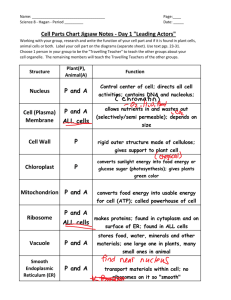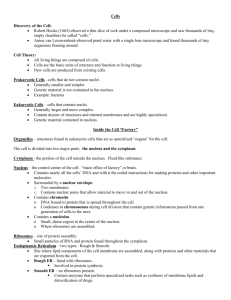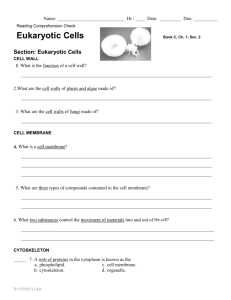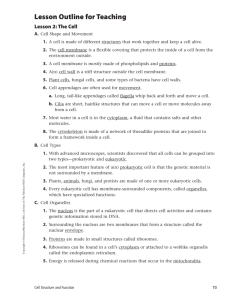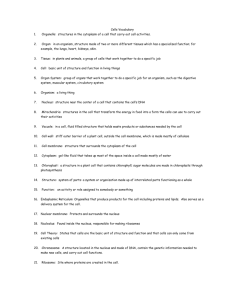Chapter 4 A Tour of the Cell
advertisement
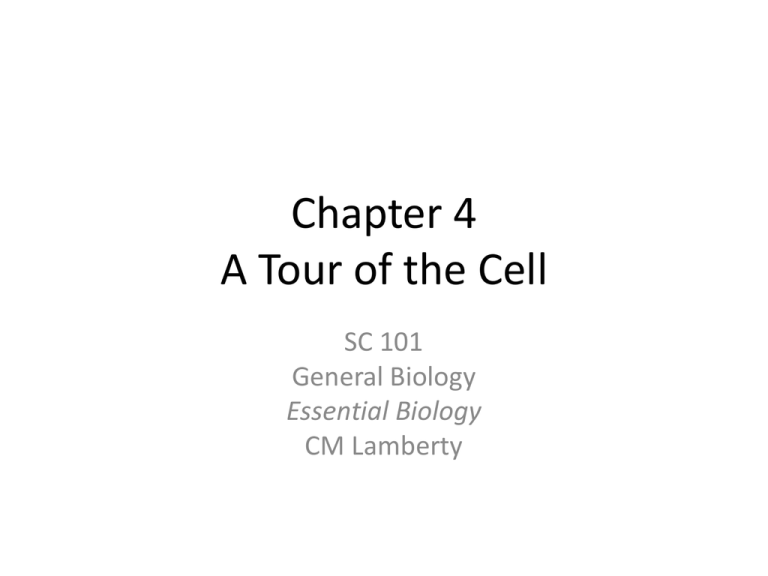
Chapter 4 A Tour of the Cell SC 101 General Biology Essential Biology CM Lamberty The Microscopic World of Cells • • • • Cells are marvels of complexity Trillions of cell in human body Many specialized types Main tool for exploration--Microscope Microscopes as Windows on the World of Cells • Light Microscope (LM) – Visible light projected through specimen – Lenses enlarge the image and project to eye – View living cells • Magnification – Increase in size, depends on lens • Resolving Power – Clarity of magnified image • Electron Microscope (EM) beam of electrons – Scanning Electron Microscope (SEM) • View cell surfaces – Transmission Electron Microscope (TEM) • View internal structures Microscopes as Windows on the World of Cells Microscopes as Windows on the World of Cells The 2 Major Categories of Cells The countless cells on earth fall into two categories: • Prokaryotic cells — Bacteria and Archaea • Eukaryotic cells — plants, fungi, and animals All cells have several basic features. • They are all bound by a thin plasma membrane. • All cells have DNA and ribosomes, tiny structures that build proteins • All cells have cytosol (aka cytoplasm) The 2 Major Categories of Cells Prokaryotic and eukaryotic cells have important differences. Prokaryotic cells are older than eukaryotic cells. • Prokaryotes appeared about 3.5 billion years ago. • Eukaryotes appeared about 2.1 billion years ago. Prokaryotes • • • • Are smaller than eukaryotic cells Lack internal structures surrounded by membranes Lack a nucleus, DNA is contained in a nucleoid Have a rigid cell wall Idealized Prokaryotic Cell The 2 Major Categories of Cells Eukaryotes • Only eukaryotic cells have organelles, membranebound structures that perform specific functions. • The most important organelle is the nucleus, which houses most of a eukaryotic cell’s DNA. Idealized Eukaryotic Cell Overview of Eukaryotic Cells • Eukaryotic cells are fundamentally similar. • The region between the nucleus and plasma membrane is the cytoplasm. • The cytoplasm consists of various organelles suspended in fluid. • Unlike animal cells, plant cells have • Protective cell walls • Chloroplasts, which convert light energy to the chemical energy of food Membrane Structure • Separates living cell from nonliving surroundings • Regulates traffic of chemicals in and out of cell • Key to how it works is the structure Plasma Membrane: Lipids & Proteins • Phospholipids – Related to dietary fats – Only 2 fatty acid tails not 3 • hydrophobic – Phosphate group in 3rd position • Charged, hydrophilic • Phopholipid bilayer – 2-layered membrane – Proteins embedded in bilayer • Regulate traffic Plasma Membrane: Lipids & Proteins • Fluid Mosaic – Not static (fluid) – Diverse proteins (mosaic) – Phospholipids and proteins free to drift about in the plane of the membrane • Illness can result if membrane is compromised – Superbugs: staphylococcus aureus – MRSA – Flesh eating disease!! Cell Surfaces • Plant cells have rigid cell wall surrounding plasma membrane – – – – Made of cellulose Protect the cells Maintain cell shapes Keep cells from absorbing too much water • Cells connected via channels through cell walls – Join cytoplasm of each cell to neighbor – Allow water and small molecules to move between cells Cell Surfaces • Animal cells lack cell wall – Extracellular matrix • Sticky coating to hold cells together • Protects and supports cells • Cells junctions – Connect cells together – Allow cells in tissue to function in coordinated way Genetic Control of Cell • Nucleus chief of the cell – Genes store information necessary to produce proteins – Proteins do most of the work of the cell – Contains “MOST” of the cells DNA Structure and Function of Nucleus • Nuclear Envelope – Double membrane that surrounds nucleus – Similar in structure to plasma membrane – Pores allow transfer of materials- pore complex passes through the double membrane – Inner portion is covered in a nuclear lamina • Nucleolus – Prominent structure – Here a type of RNA called rRNA is made by DNA instructions • Chromatin – Fibers formed from long DNA and associated proteins • Chromosome – One chromatin fiber The nucleus DNA, chromatin and chromosomes Ribosomes • Responsible for protein synthesis • In eukaryotic cells, ribosomes are made in nucleus and by RNA called ribosomal RNA (rRNA) and then transported into cytoplasm where small and large subunits join – Suspended in fluid making proteins that remain in fluid – Attached to outside of endoplasmic reticulum, making proteins incorporated into membranes or secreted by cell – Free ribosomes function in cytosol, ie for glysolysis How DNA Directs Protein Production • DNA programs protein production in cytoplasm via mRNA • mRNA exits through pores in nuclear envelope, travels to cytoplasm, and binds to ribosomes • As ribosomes move along mRNA, genetic message translated into protein with specific amino acid sequence. How DNA Directs Protein Production DNA RNA Protein The Endomembrane System • Cytoplasm of eukaryotic cells partitioned by organelle membranes • Some are connected – Directly by membranes (which are not always identical) – Indirectly by transfer of membrane segments or tiny vesicles • Together form endomembrane system – Includes nuclear envelope, endoplasmic reticulum, Golgi apparatus, lysosomes and vacuoles Endoplasmic Reticulum (ER) • Main functioning facility in cell • Continuous with Nuclear Envelope • Rough ER – Ribosomes stud the surface – Produce membrane and secretory proteins (i.e. salivary glands) – Products transferred via transport vesicles • Smooth ER – Lacks ribosomes on surface – Synthesis of lipids (steroids) – Helps liver detoxify drugs Endoplasmic Reticulum (ER) The Golgi Apparatus • Refinery, warehouse and shipping center • Products made in ER reach Golgi in transport vehicles • Receiving dock and shipping dock • Modifications by enzymes as products move from receiving to shipping – Phosphate groups added as tags for different destinations – CIS face is the receiving side – TRANS face is the transporting and delivery side The Golgi Apparatus Lysosomes • Sac of digestive enzymes (animal cells) • • • • Proteins Polysaccharides Fats Nucleic acids • Develop from vesicles budding from Golgi • Food vacuoles – fuse with lysosomes, exposing food to enzymes for digestion – Small molecules from digestion leave the lysosome and nourish the cell. • Breakdown damaged organelles • Sculpturing feature – Digest webbing between fingers and toes Lysosomes Vacuoles • Sacs that bud from ER, Golgi or plasma membranes • Variety of size and function – Contractile vacuoles of protists pump out excess water in the cell. – Central vacuoles of plants • Store nutrients • Absorb water • May contain pigments or poisons Vacuoles Review of Endomembrane System Chloroplasts and Mitochondria • Energy Conversion • Cellular power stations Chloroplasts • Photosynthetic cells of plants and algae • 3 compartments – Space between membranes that surround chloroplast – Stroma: thick fluid – Network of disks and tubes • Grana: interconnected stacks of disks • Solar power pack Chloroplasts Mitochondria • Site of cellular respiration – Harvest Energy from food and converts to ATP • Found in all eukaryotic cells • Structure – Enveloped by 2 membranes filled with matrix – Inner membrane has several infoldings (cristae) • Contain DNA that encodes their own protein Mitochondria Endosymbiont Theory • Theory states that an early ancestor of eukaryotic cells engulfed an oxygen using non photosynthetic prokaryotic cell. Eventually, the engulfed cell formed a relationship with the host it was enclosed, becoming an endosymbiont. Eventually these 2 merged into a single cell which was a eukaryote with mitochondria. • At least one of theses mitochondrion endosymbiont cells also took in a prokaryotic cell containing chloroplasts leading to plant life Endosymbiont Theory Supports • Unlike endomembranous organelles with one membrane, chloroplasts and mitochondria have double membranes surrounding them • Both contain ribosomes and their own DNA attached to inner membranes • Bothe are somewhat independent and grow and reproduce within the cell. Peroxisomes • Detoxify harmful substances that enter the cell. • Seen especially in kidney and liver • Contain peroxidase and catalase (some chemical reactions in the body create hydrogen peroxide which is toxic to cells. Peroxidase breaks this down. The Cytoskeleton • Network of fibers extending throughout cytoplasm • Skeleton and muscles – Support and movement Maintaining Cell Shape • Series of fibers – Microtubules • Straight hollow tubes composed of proteins • Guide movement of chromosomes when cells divide – Intermediate filaments and Microfilaments • Both thinner and solid • Give shape much like keratin in dead skin – ACTIN filaments- smallest fibers • Anchorage and reinforcement for organelles • Dynamic cytoskeleton (amoeboid movements) Cytoskeleton • Microtubules – Made of tubulin- globular protein • DIMER- molecule with 2 subunits alpha and beta – Supports cell shape and tracks for organelles. – Animal cells have a CENTROSOME- near nucleus that acts as an organizing center for microtubules. • CENTRIOLES are located within the centrosome and have 9 sets of triplet microtubules arranged in a ring ACTIN • Actin filaments are smaller than intermediate fibers and work with other proteins to contract muscle tissue. • In plants the interaction of actin and myosin cause a cytoplasmic streaming- circular flow of cytosol that helps speed distribution of materials in the cell Maintaining Cell Shape Cilia and Flagella • Mobile appendages • Aid in movement • Flagella – Generally occur singly – Propel cell – Undulating whiplike motion • Cilia – Shorter and more numerous than flagella – Promote movement by back and forth motion – Some function to move fluid over tissue surfaces Cilia and Flagella Extracellular Matrix (ECM) • Animals have an elaborate ECM made of glycoproteins (aka proteoglycans). Most abundant proteoglycan is COLLAGEN. • Collagen makes up 40% of protein found in humans. Collagen is secreted from the matrix • Some cells attach to ECM by proteins called INTEGRINS. ECM integrins transmit signals to the ECM and cytoskeleton and integrate changes occurring outside and inside the cell. – Current research suggests that these ECM integrins can regulate cell behavior and may even influence the nucleus of the cell.
